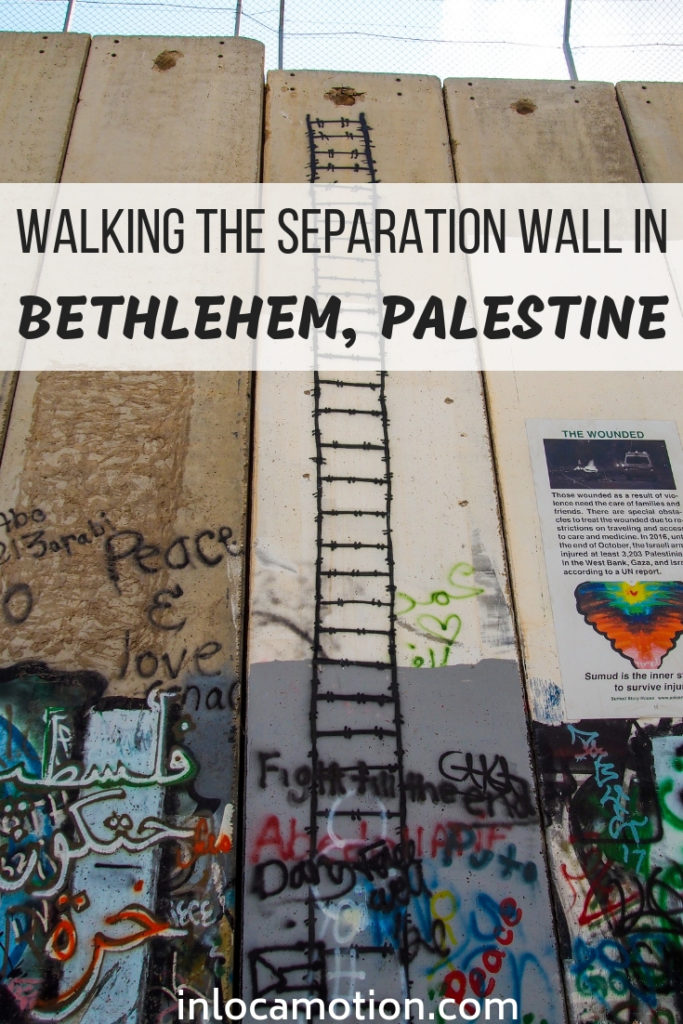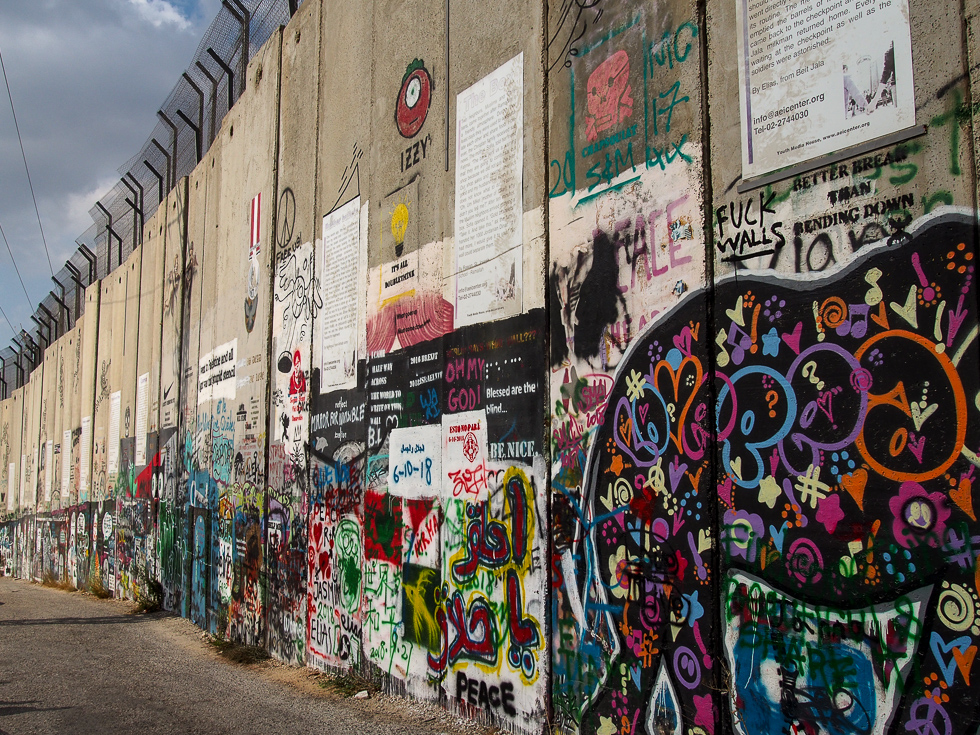
A section of the separation wall in Bethlehem, Palestine
It is impossible to miss the separation wall when traveling in the West Bank. It is a hulking, concrete snake that twists and turns its way throughout the land, lining highways, surrounding villages, and cutting through cities. One section of the wall runs through Bethlehem, Palestine, a charming city with great religious and historical significance. I highly recommend Bethlehem as a destination for travelers in the West Bank, and in particular I recommend that travelers take a walk along the separation wall, which is covered by a massive array of artwork. The artwork is highly political, and images range from promotions of peace, to expressions of anger, to calls for justice in Palestine from the ongoing Israeli occupation.
This post is about the separation wall. Here I detail the history of the wall and some of its impacts on Palestinian life, and I share a brief photo essay showing images of resistance that I found along the wall. Read on for everything you need to know about the separation wall, travel in Bethlehem, and more.
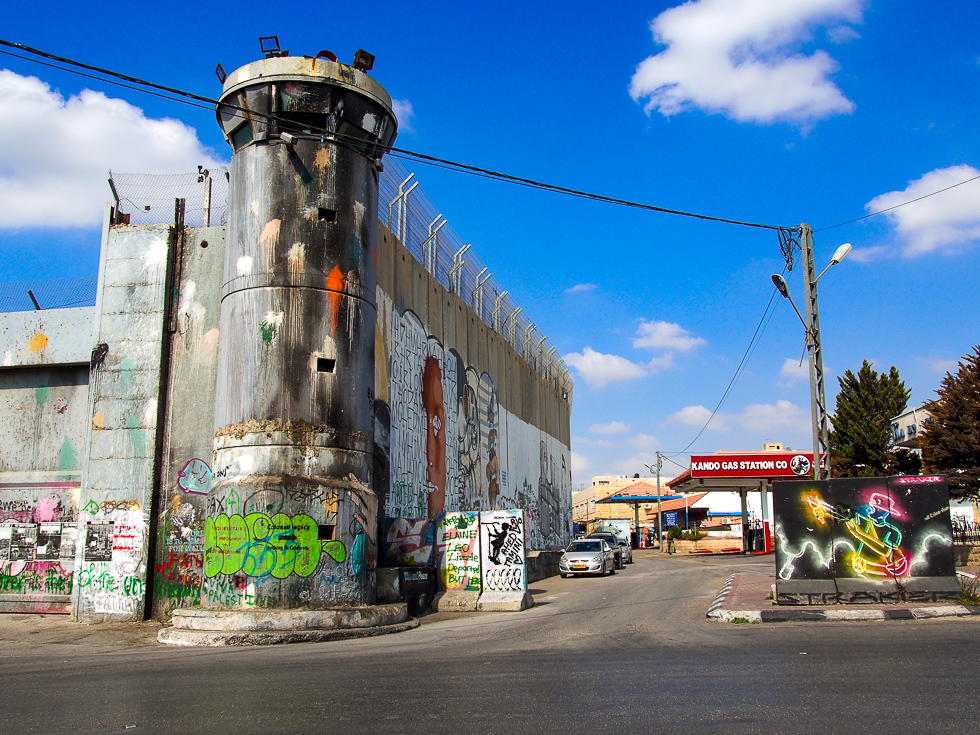
Watchtowers and barbed wire along the wall in Bethlehem
Wall 101: history and information about the separation wall
The wall was built during the Second Intifada, a period of heightened conflict between Israel and Palestine that occurred between 2000 and 2005. Construction began on the wall in 2002, cited as a security measure to prevent suicide bombers from entering Israel from the West Bank. Only about 15% of the wall runs along the Green Line (the Israel-Palestine border established in 1967). The remaining 85% of the wall is located inside of the West Bank, and in some places stretches as far as 18 kilometers into the West Bank.
As of now, the wall is incomplete, though between what has already been constructed and what is planned for future construction, the wall is meant to extend approximately 442 miles (712 kilometers) long upon completion. For reference, the Green Line is approximately 200 miles long, so the separation wall will more than double the length of the Green Line. In some sections, the wall consists of an electric fence, and it others it consists of a concrete barrier that is about 8 meters tall (26 feet). It is replete with watchtowers and barbed wire. There is a series of 84 gates located along the wall, controlled by the Israeli military, that allow Palestinians to pass through to the other side; however, the gates are not necessarily opened daily (according to Israeli human rights group B’Tselem, only 9 are opened daily, and 10 are only opened a few days a week). The construction of the wall resulted in the destruction of many Palestinian homes, farmlands, and businesses that were located along its route.
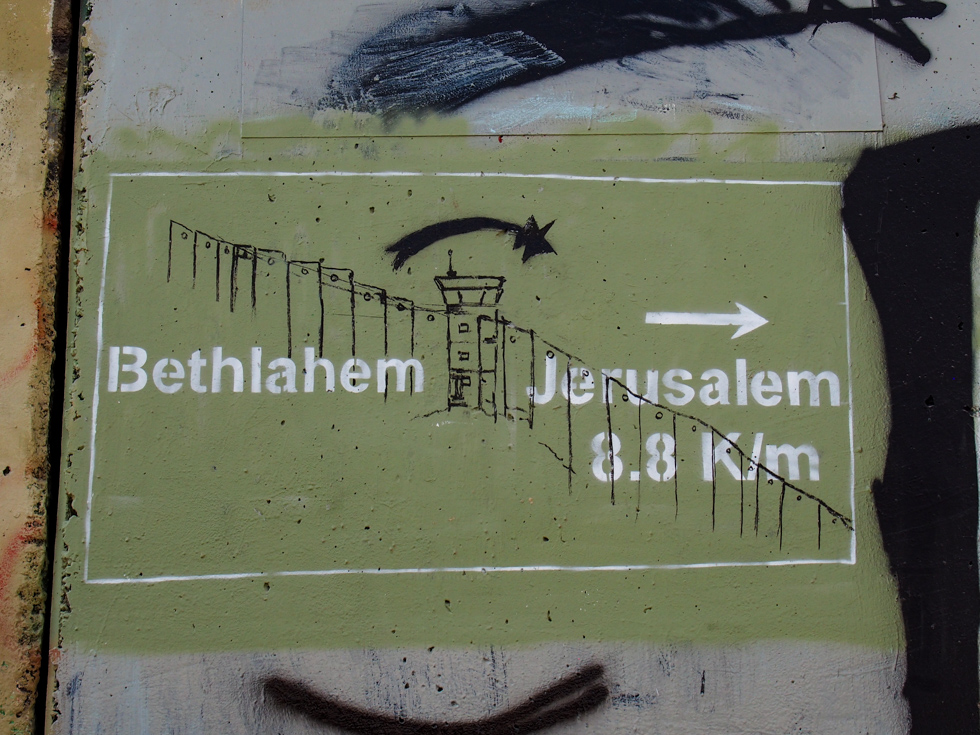
Artwork on the wall depicting the distance between Jerusalem and Bethlehem, and how the wall divides communities
Some implications of the separation wall in Palestine
Although Israel cites the wall as an effective security measure, most Palestinians and anti-occupation advocates view it as a tool of apartheid that undermines the possibility for a future Palestinian state. The route of the wall was largely determined by the locations of Israeli settlements within the West Bank (and here it is important to note that Israeli settlements in the West Bank are considered illegal by international humanitarian law). The location of the wall essentially annexes this land for future settlement expansion, and upon completion of the wall almost 10% of total land in the West Bank will become annexed.
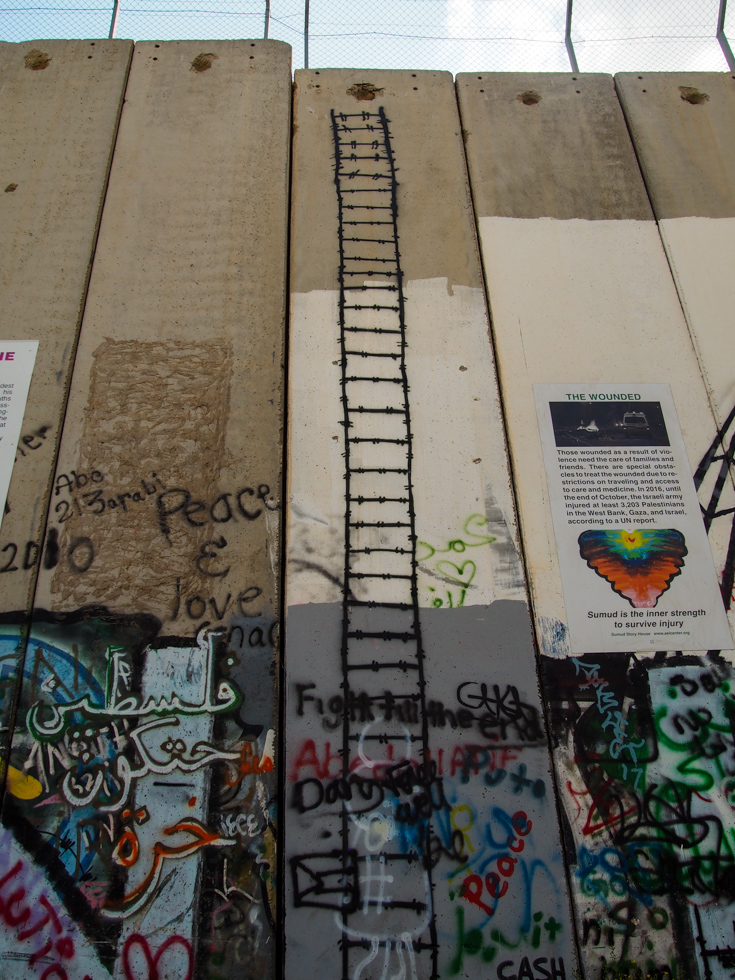
Some graffiti on a section of the separation wall
The wall serves to bisect Palestinian land and isolate communities, and generally drastically affects life for the Palestinians, particularly those who live nearby the wall. Communities that formerly were able to easily access major nearby cities, such as Jerusalem, Ramallah, Hebron, and others, now face restrictions in movement, and need to be granted permits by the Israeli military and navigate checkpoints in order to complete what was once a simple journey. According to Haaretz, after the construction of the wall, approximately 5,000 business in East Jerusalem had to close, as the majority of their clientele was no longer able to easily arrive in Jerusalem. It is also important to note here that Israelis are exempt from having to obtain permits to cross to the other side of the wall.
There are approximately 11,000 Palestinians who live to the west of the separation wall, who are effectively isolated from the rest of the West Bank (this number does not include the Palestinians who are considered to be part of Jerusalem). The Palestinians who live in this section must obtain residency permits (valid for up to two years and which must be continually renewed) in order to continue living in their homes. These residents can only enter or leave their communities through gates installed along the separation wall that are opened arbitrarily (the opening of the gates is determined by the Israeli military). This impedes business and economic development, and it also cuts off these residents from previously accessible education and medical services. Furthermore, it alters the social fabric of Palestinian society. Families and friends who were previously able to easily visit one another are now at the mercy of permits in order to visit their loved ones on the other side of the wall.
Palestinians farmers with land nearby the wall were particularly affected by its construction. The wall cuts through valuable farmland in the West Bank, obstructing Palestinian farmers from being able to access their land. Many gates along the wall only open a few days a year, during the olive harvesting season. Farmers with restricted access to their land cannot properly tend to the crops, resulting in crop degradation and loss of income. It is estimated that upon completion of the wall, approximately 15% of total agricultural land in the West Bank will be lost.
For more information about how the wall affects Palestinian life, see this general overview of the wall and its impacts, this resource about the environmental impacts of the wall, and this resource about the economic impacts of the wall on the Palestinian labor market.
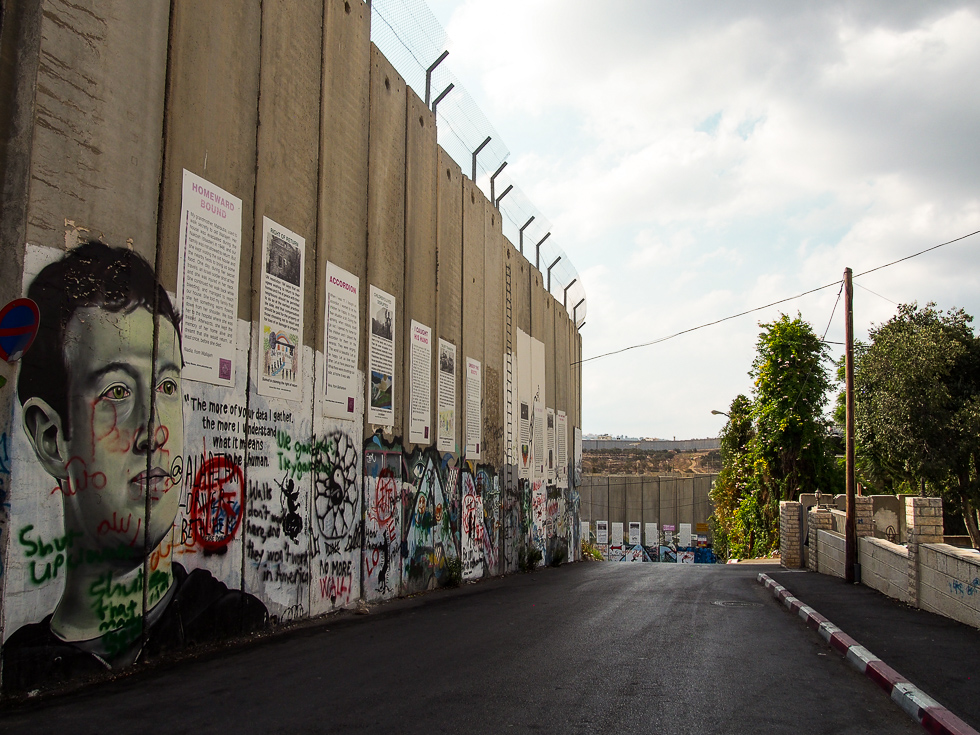
Multiple sections of the separation wall – can you see it continue in the distance?
Walking the wall: a journey in photos
I found walking the wall to be a very powerful, emotional, and informative experience. There is a beauty to the artwork on the wall, but it is a tragic beauty, one that has grown out of human suffering. I found it simultaneously heartbreaking and empowering to see the words and images of resistance along its surface. Every artist has a different story to tell: some are hopeful, some are pessimistic, some seek to educate, some use humor as a means with which to deal with the reality of life under occupation. Here I will leave you with some photos, everything from small tags to giant murals, using art as a mechanism for Palestinian resistance along the separation wall.
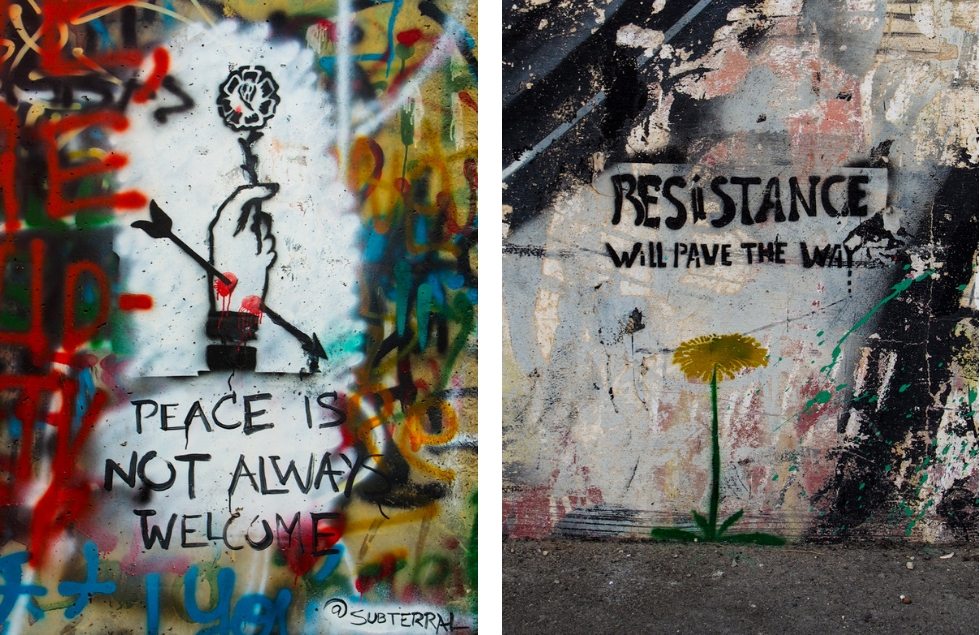
Left: “Peace is not always welcome”; Right: “Resistance will pave the way”
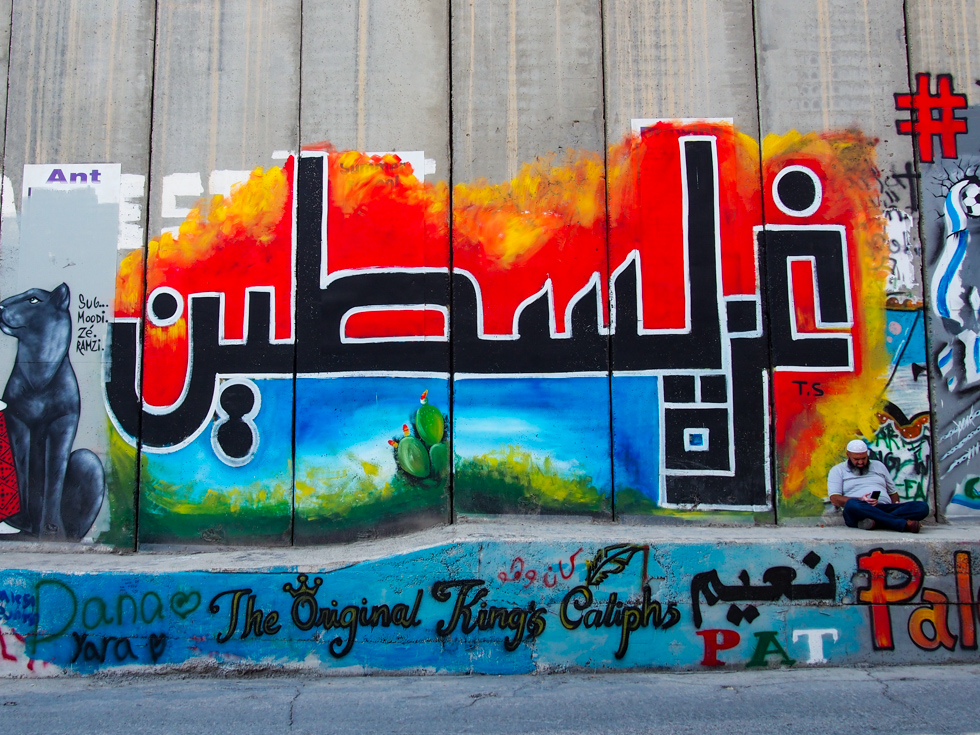
This script is a combination of two words: Palestine and Gaza
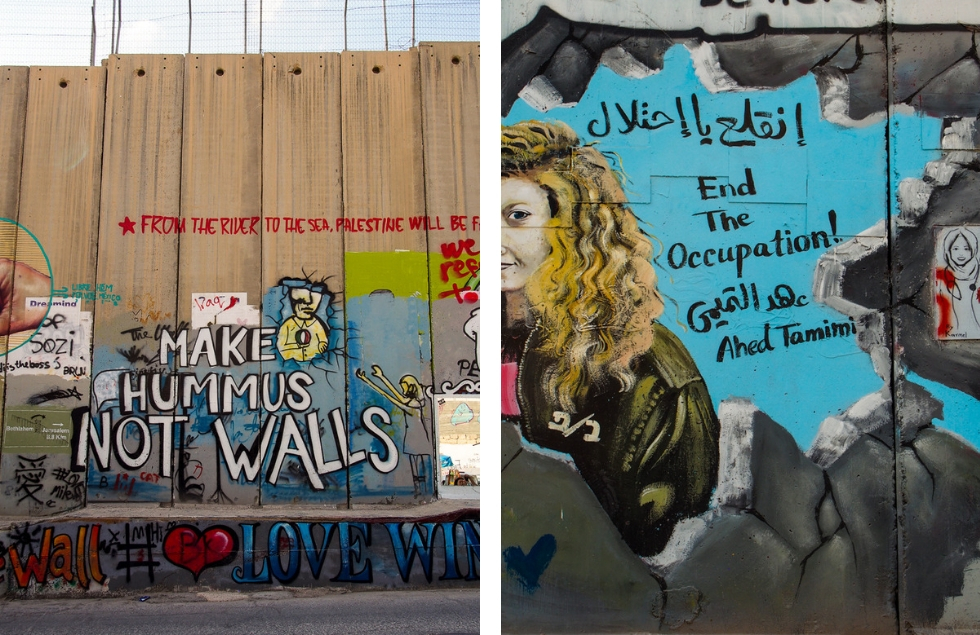
Left: “Make hummus not walls”; Right: “End the occupation!” and portrait of Ahed Tamimi, a Palestinian teenager who was imprisoned for 8 months after slapping two Israeli soldiers in the face
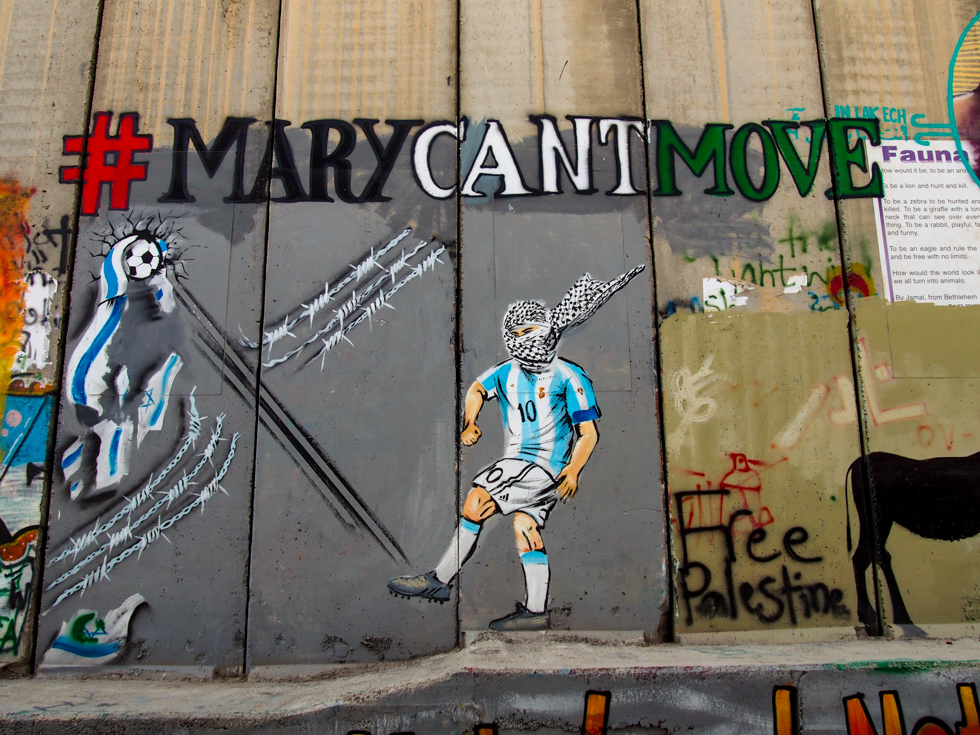
“#marycantmove” refers to the fact that Palestinians have incredibly limited freedom of movement; the biblical figures Mary and Joseph, were they alive today, would not have been able to make their famous journey to Bethlehem
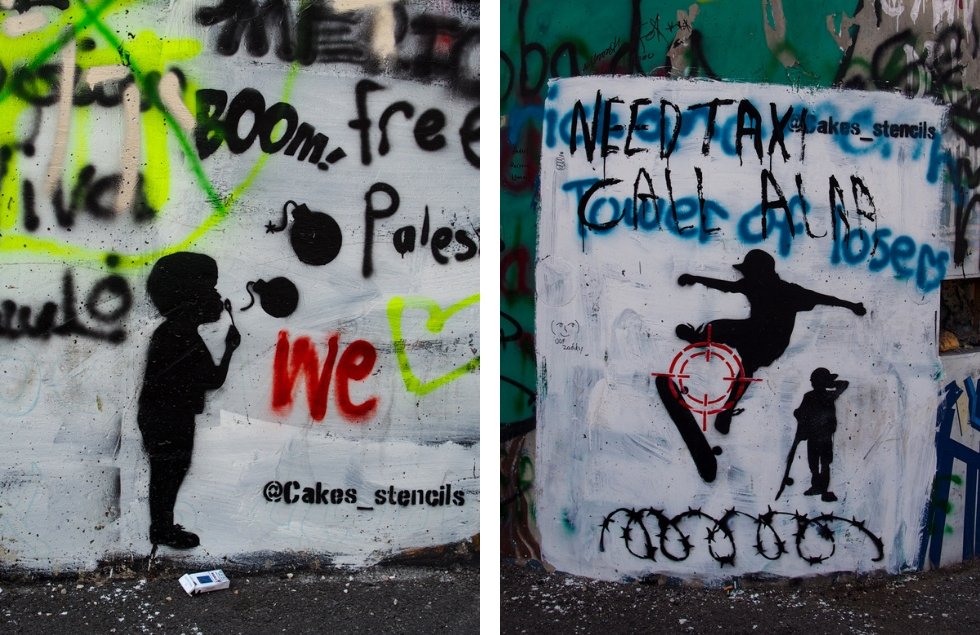
Small illustrations along the wall
The wall in stories
Also interspersed along the wall are a series of informational and narrative posters, compiled and put up by the Arab Educational Institute (AEI), a Palestinian organization that seeks to further education, peace building, and dialogue in Bethlehem, Ramallah, and Hebron. The posters include short narratives by Palestinians who have been affected by the wall, as well as informational posters detailing various aspects of life under occupation. I’m including some snapshots of posters that particularly stood out to me during my walk, but for more posters and information check out AEI’s archive of wallposters.
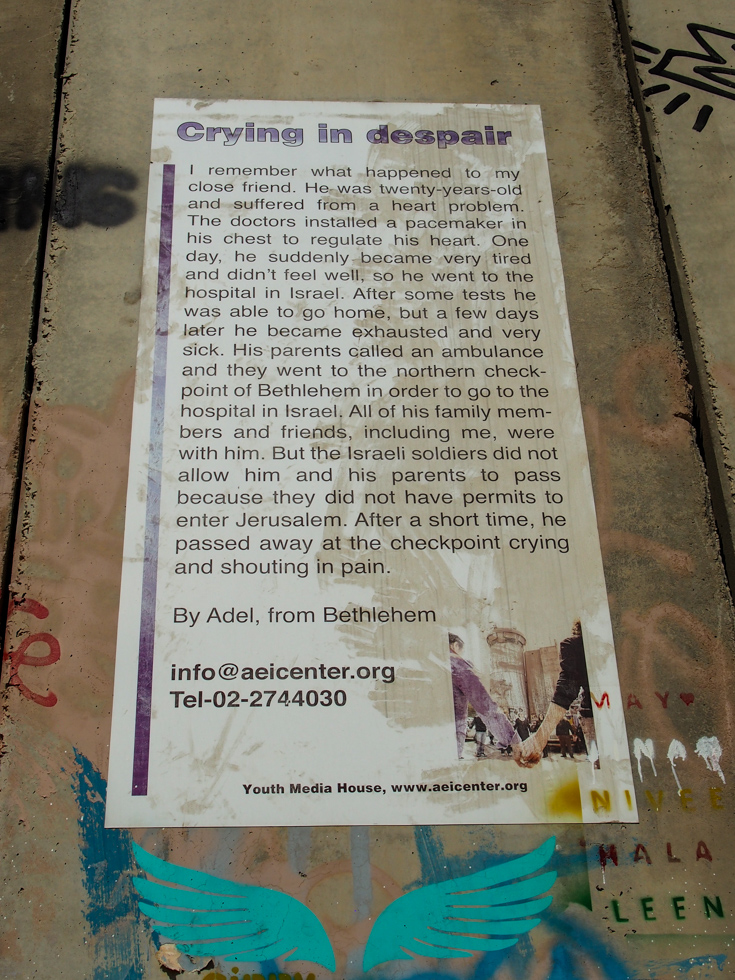
Tragic narrative detailing the implications of needing permits to travel everywhere… including the hospital
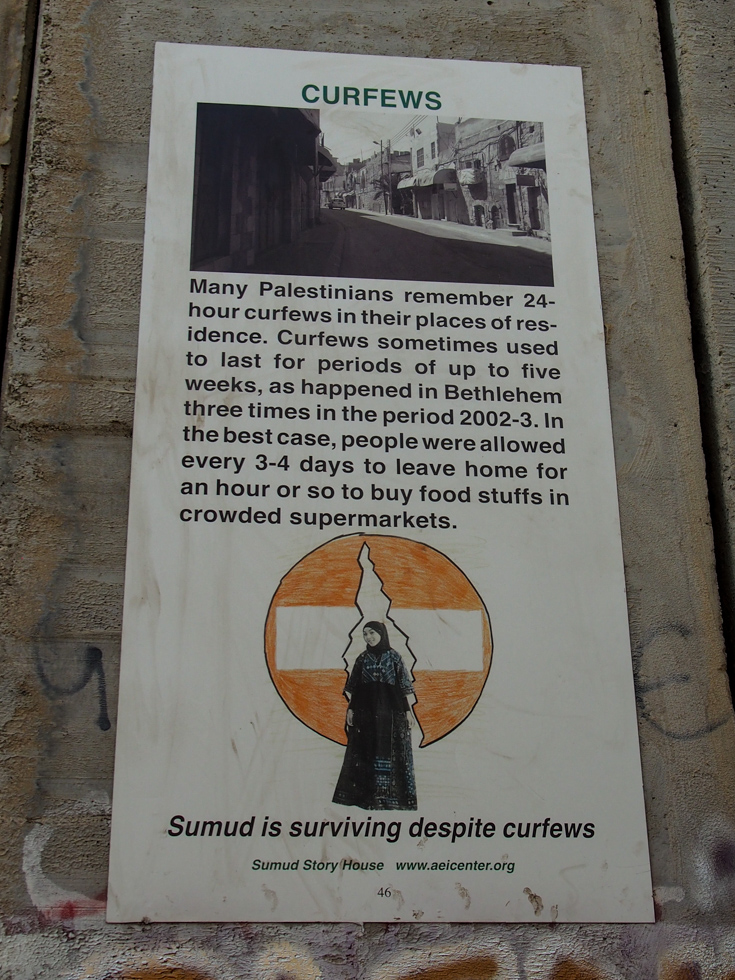
Informational poster detailing how curfews impact Palestinians
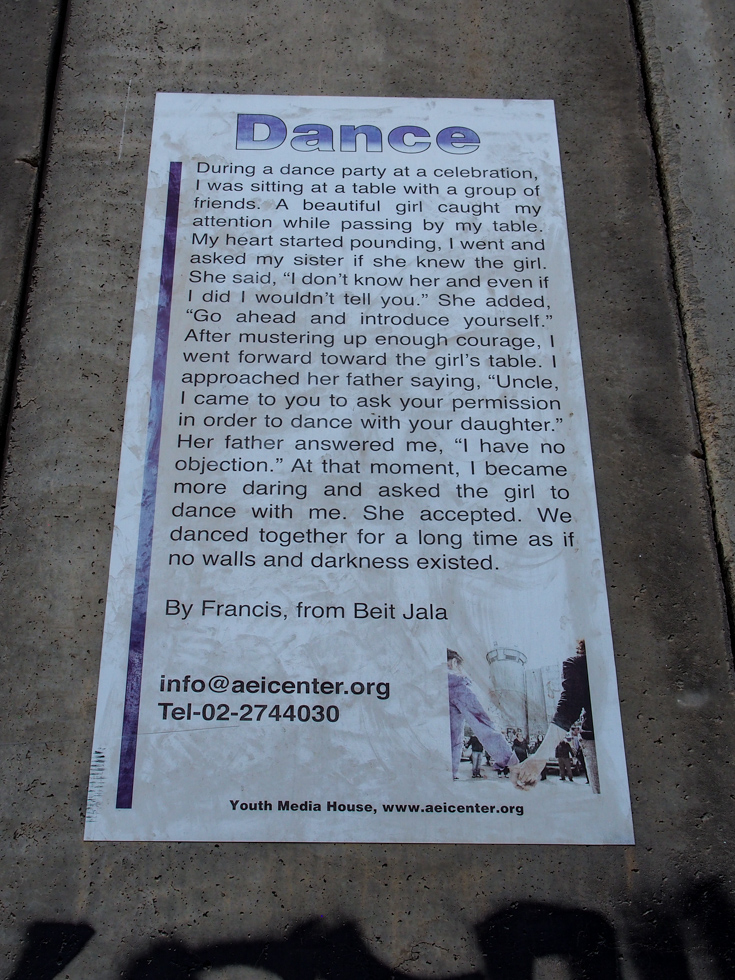
As a dancer, this one made me cry…
Bethlehem, Palestine: an itinerary and some travelers’ notes
Bethlehem is a beautiful city and well-worth the visit. I recommend allotting a few hours out of your day to walk along the wall. You can also visit the Walled Off Hotel (created by British artist Banksy, and it contains an art museum inside). Generally, there is plenty to see and do around the city of Bethlehem; I spent only one night there, but in retrospect I would have preferred to stay longer: at least two nights, potentially three.
I recommend walking from the wall into the old city of Bethlehem via Manger Street, which twists around the city and offers some pretty incredible, sweeping views of the surrounding landscape. The old city is very charming and lovely to walk around in. It also contains some very important Christian sites, including the Church of the Nativity (the birthplace of Jesus) and the Milk Grotto Church. Note that to enter the crypt where Jesus was born, you will likely have to stand on line for about 1 hour, as this is a very popular tourist destination.
Otherwise, you can visit the Bethlehem Museum (a museum about Palestinian life and culture). You can also visit nearby Aida Refugee Camp.
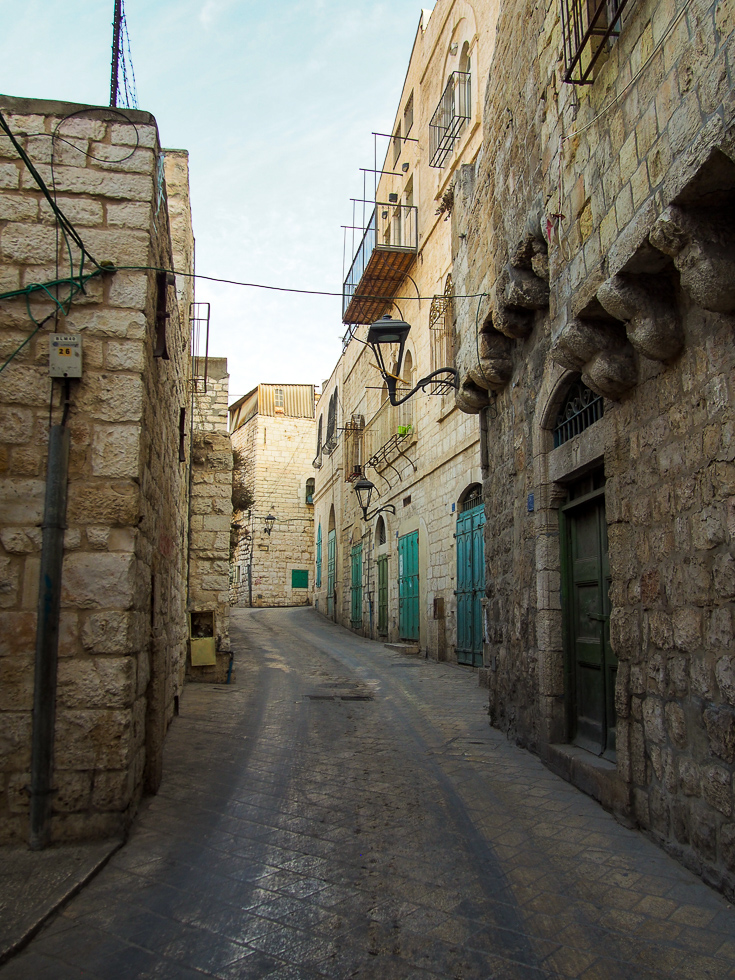
Quiet streets in the old city of Bethlehem, Palestine
Prices in Bethlehem are comparable to other Palestinian cities. It’s a city that’s very solo travel friendly, so don’t feel that you have to go with a tour group if you don’t want to. I will note that Bethlehem is not quite as walkable as Ramallah. Yes, the old city is charming to walk around in, but it’s quite small and there isn’t the same energy in the streets as in Ramallah. I definitely recommend spending time in both, but I prefer Ramallah as a base for other travel in the West Bank.
For backpackers in Bethlehem, I recommend Habibi Hostel. It’s about a 15 minute walk from the old city, and a lovely hostel with super helpful and friendly Palestinian staff. A great base for travelers in Bethlehem.
Getting to Bethlehem, Palestine (and getting to the separation wall)
To get to Bethlehem from Jerusalem, you will need to take a bus from Damascus Gate (in East Jerusalem). The buses for Bethlehem leave from the westernmost bus terminal and cost approximately 7 shekels. It is a journey of about 1 hour from Damascus Gate to Bethlehem, and you don’t need to pass through any major checkpoints to arrive. Regardless, make sure to carry your passport on you. The buses from Jerusalem will drop you off on Hebron Road; you will not arrive at a bus station, but instead will get dropped off on the side of the street. Walk north on Hebron Road for about 10 minutes and you will arrive at the separation wall. Note that you can also get to Bethlehem (and elsewhere in the West Bank) from Jordan, via the Allenby Bridge crossing.
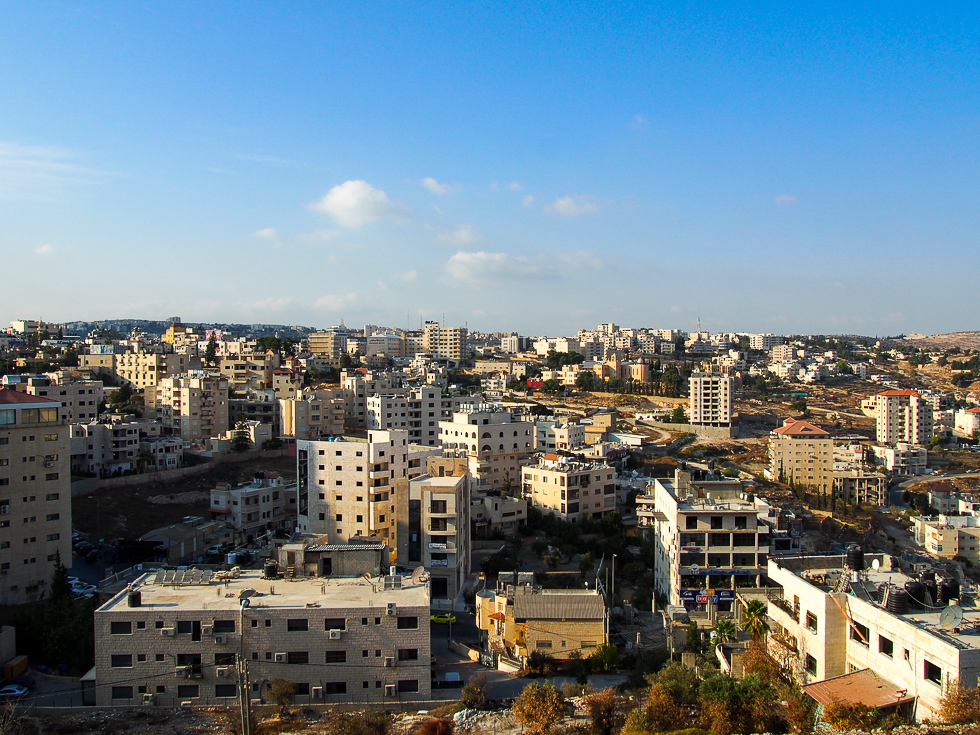
View of the outskirts of Bethlehem, Palestine
Concluding thoughts on the separation wall
I believe that it is valuable for travelers to see the separation wall, as it is a part of the reality of life for the Palestinian people and a symbol of the occupation. However, travelers should be mindful that the wall is not a tourist attraction, but rather a place of mourning: visit and photograph with respect. Also, please refrain from adding your own graffiti to the wall, as the wall is a place in which Palestinians can express themselves, not a canvas for tourists. Visits to the wall should be made in solidarity with Palestinians, though remember that a great way to show solidarity is to patronize local establishments, donate to local organizations, and work to spread awareness of the situation in Palestine with others.
Finally, remember that while viewing the wall, talking about the wall, and appreciating the use of art as a form of resistance along the wall, it is important not to exoticize or fetishize Palestinian trauma. The wall is a symbol of subjugation and apartheid for the Palestinians. In spite of the presence of artwork, it is important that the wall be viewed as temporary. Palestinian artist “Issa” said it best: “The more we reproduce images of the wall, the more the wall becomes normal in people’s imagination. Then our imaginary [sic] stops at the wall. It becomes the first subconscious image of Palestine.”
What do you think of the graffiti and artwork along the separation wall? Should non-Palestinians be able to add their own tags? Do you think that walls are an effective security measure? Would you visit Bethlehem (and if so, would you visit the wall)? Why or why not? Let me know in the comments below!
